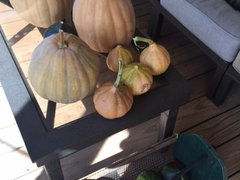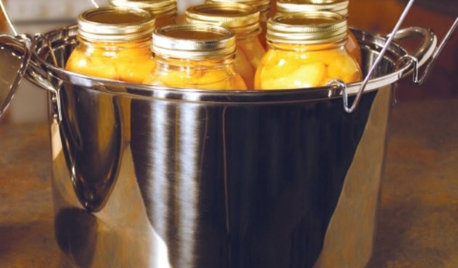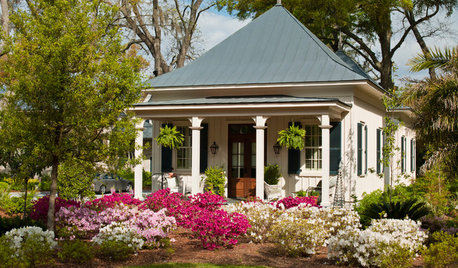Seminole Pumpkin -- New Strain Available
The Back Story: A couple of years ago, Carol (Soonergrandmom) planted commercially-purchased seeds of Seminole Pumpkin, an heirloom winter squash originally grown in what is now Florida by the Seminole indians centuries ago. Her plants yielded extra-large fruit that looked similar to Seminole but were much longer. Even allowing for the fact that there is some shape and size variation within the Seminole pumpkin seed line, these were far beyond the sizes of Seminole pumpkins normally seen.
Now: While flipping through the newly-arrived 2014 catalog from Southern Exposure Seed Exchange, I noticed that one of their new offerings for the coming growing season is a new strain of Seminole Pumpkin that produces larger fruit than the strain so many of us have grown in the past.
Carol, I thought of you and your gigantic Seminole pumpkins as soon as I saw this new listing in the catalog.
Dawn
Here is a link that might be useful: Seminole Larger Fruited Pumpkin listing
Comments (19)
soonergrandmom
10 years agolast modified: 9 years agoInteresting. Well mine was bigger, but it didn't look like that picture either.
Shelley Smith
10 years agolast modified: 9 years agoInteresting! These are the ones that are immune to squash bugs, right? What do they taste like? They look kinda like butternut to me, but a different shape.
Shelley
Related Professionals
Dixon Landscape Contractors · Galt Landscape Contractors · Mount Kisco Landscape Contractors · Nashua Landscape Contractors · San Benito Landscape Contractors · San Pablo Landscape Contractors · Aberdeen Decks, Patios & Outdoor Enclosures · Ankeny Decks, Patios & Outdoor Enclosures · Del City Decks, Patios & Outdoor Enclosures · Des Moines Decks, Patios & Outdoor Enclosures · Lansdale Decks, Patios & Outdoor Enclosures · Montgomery County Decks, Patios & Outdoor Enclosures · Northglenn Decks, Patios & Outdoor Enclosures · Salem Decks, Patios & Outdoor Enclosures · Sun Lakes Decks, Patios & Outdoor EnclosuresOkiedawn OK Zone 7
Original Author10 years agolast modified: 9 years agoCarol, I know it doesn't look like yours, but I'm still not sure yours was Seminole, even though it grew all over the place like Seminole. Because Seminole comes in various shapes and sizes and even color variations, we know it is unstable. (hee hee, like some people we know, perhaps) The fact that other people are getting different shapes and sizes from yours but that also are larger than the standard Seminole pumpkins makes me wonder if a big batch of seed raised somewhere and sold commercially might have crossed with a standard butternut or some other C. moschata.
Shelley, I won't say they are immune to the diseases spread by squash bugs, but I'd say they are 99% immune. However, they have solid stems which largely prevents the squash vine borer grubs from tunneling through the stems and killing them, and that is a trait shared by other squash in the C. moschata family. Seminoles are in the same family as butternuts but I like their flavor better and they store forever, forever, forever. I have some in my garden shed that were harvested in the late fall of 2012 and they still are in good shape. The longer they sit in dry storage, the sweet they get. Since I have a lot more stored in the garage from the last harvest of November 2013, I've been feeding the last few from 2013 to the deer. I just slice them up and toss the slices or chunks on the ground for the deer shortly before sunset, and the deer are out there eating them practically before I walk 100' back to the house. Because our garden is large and the harvest generally is bountiful, I usually an put up enough food to feed us all year and have plenty left over to feed the wildlife. It is one of the joys of gardening here. I've got a bunch of deer who are spoiled now, and expect to have cucumbers all summer and winter squash all fall and winter.
The Seminole pumpkins taste like your typical winter squash/pumpkin and you can use them in any recipe for pumpkin or winter squash. The pies they make are superb, but they also are great simply baked in the oven, or made into squash soup or chowder. Most, if not all, canned pumpkin sold in the USA is not from the traditional orange Halloween type jack-o-lantern pumpkin.....it is actually a winter squash. To clarify it further, pumpkins actually are winter squash, but the pumpkins used as Halloween and autumn decorations don't have the flavor and texture of the other winter squash. I wouldn't eat anything from an orange Halloween pumpkin even if someone paid me to eat it. They are stringy and poorly flavored compared to "real" winter squash.
Seminole (and this is true of all the good varieties of winter squash) gets sweeter the longer it is stored since the starches convert to sugars, and its shell is so hard that it easily stores a year or longer. I've had some store for 18-20 months under normal household, garage or shed conditions. I have to use my biggest kitchen knife to slice them, and there are days I think it would be easier to cut them with a chainsaw. We have a chainsaw, but I've never actually gone so far as to bring it inside to cut up a Seminole pumpkin.
The Seminole pumpkins are vigorous growers, as is typical of all C. moschata varieties. I let them run wild, siting them where they can eventually move in and fill in spaces left vacant by the harvest of earlier crops, like corn. I also like to grow them on the garden fence. This year, in the new back garden, my Seminole vines ran 30 to 40' on the sandy side of the garden and even on the uphill dry clay area they ran 15-20' on very little water. I harvest them all summer most years, and generally get roughly 40-60 just from the very last harvest before a killing freeze. Even when harvested fairly small and dark green, they still turn their usual buff color and ripen while in storage. I've even harvested a month after the plants have frozen and those hard-shelled Seminoles had no cold damage inside. It is one of my favorite things to grow because of its reliability. You also can harvest them only a day to three days after they flower, and the young, small Seminoles make a great summer squash when harvested that young and tender.
Dawn
Shelley Smith
10 years agolast modified: 9 years agoThank you, Dawn - I always learn so much from your posts! I think this is a must grow for me this year. Squash bugs make it just about impossible for me to grow the regular summer squash, so if I can harvest some little Seminole ones to use like summer squash as well, that would be great! Maybe I can trellis them along the back fence and they can just go round and round my little yard lol! :)
I have been trying more winter squash this fall and some of them are really good. Butternut is my favorite so it sounds like I would really like the Seminoles too. Winter squash is such a versatile food (and very healthy too!) I had no idea they kept that well so that's another plus.
Thanks again for all the great info!
Shelley
Macmex
10 years agolast modified: 9 years agoI probably won't grow Seminole any time soon. But it would be really easy to fall to the temptation. I often recommend the variety to local people who want to start gardening. In my mind that family of squash (c. moschata) is the way to go. The varieties, within that family, which are specially noted for thriving in our conditions, are AWESOME!
This year I have to grow out Warsaw Buff Pie Pumpkin. My seed is getting old. But my wife and are are both of the opinion that we MUST always grow Old Timey Cornfield Pumpkin, because of its reliability. So, I will be hand pollinating ;)
George
Tahlequah, OKOkiedawn OK Zone 7
Original Author10 years agolast modified: 9 years agoShelley, You're welcome. I was thinking of your back fence when I mentioned that mine climb the fencing. You might have to regularly redirect the vines to keep them from creeping into your potager-style garden and taking over the whole thing, but that is pretty easy to do.
Squash bugs are a huge pain in the neck to deal with and some years they are just so awful. Rather than deal with growing squash under hoops, I usually just happily harvest my squash until the bugs spread a disease to the plants that kills them, and then I just start harvesting some C. moschata types very young as summer squash. The main difference between the summer squash and winter squash we eat is merely that the summer squash are harvested very young and the winter squash are harvested at full maturity. So, any winter squash becomes a summer squash if you harvest it just a couple of days after the flower is pollinated. You also can harvest and eat squash blossoms too, and since Seminole flowers and fruits so prolifically, that makes them even more of a multi-tasking plant.
I second what George said about C. moschata types thriving in our climate. It might help to think of them as what they are--tropical plants. Because they thrive in tropical areas, they tolerate extreme heat, extreme humidity and heavy rainfall. Extreme to Exceptional Drought might slow them down a little if you aren't irrigating but the plants still continue to grow and set fruit. In the summer of 2011, mine stopped flowering for a few weeks when our high temperatures were consistently over 110 and as high as 116, but once we cooled down and had highs under 110, and in particular, under 105, they resumed flowering and setting fruit. In the decade or so that I've grown Seminole, that's the only summer it got hot enough to stop Seminole from blooming and setting fruit. C. moschata types are true garden workhorses and I don't know if a person could kill one if they tried. Lots of us here in OK grow different C. moschata types for use as both winter squash/pumpkins and summer squash.
A few of the squash you regularly hear us mention that you might not realize are C. moschata include the ones George mentioned (Old Timey Cornfield Pumpkin, Warsaw Buff Pie Pumpkin), Seminole, Zuchetta/Tromboncino, Tahitian Melon (not a melon----a very elongated butternut type of winter squash), Long Island Cheese and other similar tan cheese pumpkins, and Waltham Butternut (and all other true butternut squash varieties). Many of them are a buff color instead of orange and that is one more reason to like them.
For our first 6 to 8 years here, the squash vine borers didn't find us and I grew tons and tons of squash of all kinds----often about 30 varieties per year. I had the most amazing time growing them. Then the squash vine borers found us and I gradually gave up growing most C. pepo and C. maxima types because the squash vine borers made it so hard. I still grow a couple of C. argyrosperma (formerly C. mixta) types every now and then, like green-striped cushaw or Cochiti Pueblo, because they are more disease- and pest-tolerant than the C. pepo and C. maximas I used to grow. Green-striped cushaw ranks right up there with Seminole pumpkin, although I have occasionally lost it to squash vine borers although not often.
George, I've always felt like anyone can succeed with C. moschata types, and have told some of my friends (kinda playfully but kinda seriously) "if you can't grow C. moschata plants successfully, you should give up gardening". They have so many wonderful qualities and tolerate everything our climate, weather, soils and pests throw at them.
I'm all in a gardening mood now and it is a little too early to start seeds, I suppose. Rain has been falling all night, mostly slowly but steadily, but with occasional rounds of heavier rain, thunder and lightning. Nothing gets me more in the mood to garden than having actual raindrops falling from the sky.
Dawn
hazelinok
7 years agoWow. There's a lot of Seminole pumpkin threads in this forum! :)
(I just chose one for my questions as I'm sure all the threads are great.)
So...I've planted Seminoles for the last two years. The first year, I only got one small fruit out of a maybe a half dozen vines. This year, I had quite a bit more fruit (the SVB got most of it--what?!) But a couple of fruit survived--small though. And new ones are forming everyday--the bees were so busy with them today.
The seeds I purchased are the strain mentioned on this thread--the larger fruited ones. Mine wasn't large though. Could this be depleted soil? Could this strain be more susceptible to SVB? Anyway...just thinking about things...
Okiedawn OK Zone 7
Original Author7 years agoThere's a lot of thread because Seminole is so awesome. Well, most of the time it is.
Tell us more about how you've grown it in the two years that have given you trouble.
When did you plant? (The month alone would be enough.)
Full sun? (At least 8 hours a day?)
Adequate moisture? (It does love lots of rain to support those long rambling vines that can easily run 30-35' long or more.)
Did you ever feed it? Unless you have really fertile soil or tons of rain, it is going to need some sort of regular feeding program most of the time to keep it growing and producing.
Weather? The hotter the better. Too much drought/too little moisture leads to the need for more irrigation.
The SVBs surprise me. They may get all my other kinds of squash some years, but they almost never bother Seminole at all, so I'm puzzling over that.
soonergrandmom
7 years agoObviously I didn't have an insect problem with my Seminole this year. LOL I think I harvested 14 more squash today and 3 or 4 on Saturday. I haven't weighed these but I am sure that I am over 1000 pounds by now. Mine just went crazy this year. I have a few hanging in a tree that are ready to harvest but I'm not sure how I am going to get those down.
hazelinok
7 years agoI'm a little jealous, Carol. A little. I did cook up mine today and Tom enjoyed it with his dinner.
Trouble shooting...(Just this year)
They were planted in June during the waxing moon...right after the onions were pulled out. This bed has been worked for two years now. It's one of the better areas of my garden as far as loose soil. I've added compost to it and fertilized it often with that special onion fertilizer from Dixondale (not sure if that is helpful or hurtful to pumpkins). I added an organic fertilizer when I planted the Seminole seeds and feed them Miracle Gro maybe once? They sprouted quickly and made several pumpkins. Oh...something that might matter is they were planted along with Old Fashioned Tennessee Vining pumpkins. One "hill" was Seminole and then a few feet was OFTV and so it went down the line of pumpkins....
They get sun from morning until late afternoon/early evening depending on the month. There are trees to the west of my garden.
Maybe they weren't watered often enough? Maybe they weren't fed enough. I suspect my soil is really, really deficient. But other than that, I think it was the insects. I had several fruit during the summer. And was so excited. Finally! Then these poor vines were attacked by squash bugs and I tried to clean them off every few days. Then--horror of horrors--SVB! Imagine my surprise because I thought these things were resistant to SVB. I even did an internet search and no one has had a problem with SVB in their Seminole pumpkins. Leave it to me to be the first. I pulled those vines out and some of them were so infested that the little white maggots fell out and went into the garbage. Some of the vines did not have SVB. But on the attacked ones, even the fruit--up by the steam--had SVB (or another insect) trying to bore in.
Right now, I have a few more fruit forming and no signs of squash bugs or borers...but a freeze is coming soon, I'm sure.
My soil is probably really bad. It's not even red clay--it's just hard and yuck.
An elderly man down the road built this house for his mother years ago, and when she passed he rented it out before he sold it to us. Some of the neighbors tell of a man who lived in our house who had a large tomato garden in the area of my garden--or close to it. People out here are never sure about the number of years ago or exactly where it was. They only remember that he got angry and left water sprewing from a spigot on that part of the property ...and then left during the night. Or that he made his young children work the tomato garden while he sat around. Stuff like that. Personally, I would like to know the location of the spigot that Kenneth supposedly capped off. If it's near my garden that would be awesome...just need to put a faucet on it.
Anyway...yes. Seminole. I'm going to purchase new seeds for next year. Not try to keep these.
Thanks for your help.
Macmex
7 years agoWell, I planted Seminole last year and it flopped for me. But I'm positive that it was the fault of the site. I planted it in an abandoned place that had Bermuda grass, etc. The poor plant never got established before it got overrun by Bermuda. I did almost the same thing, this year, to my Old Timey Cornfield Pumpkin. I was busy and had not left a place for it in my main gardens, so I snuck it in a couple of odd places. It just didn't work out very well.
Carol and Al gave us some of their Seminole pumpkins last week. We've been eating off of one for two suppers so far (main course was pumpkin atole). It's been good !
As an experiment, I've been digging a 3' deep trench, in the worst, rockiest part of my garden, filling it in with lots of compost. That's going to be my pumpkin patch next year.
I'm pretty sure, in 1984 I grew Thompson and Morgan's Melon Squash, in my garden in Winona Lake, Indiana. The vine borers were so bad that year that they severed two out of three of those vines, right where they came out of the ground. But the crazy things had already rooted along the stem. All three plants produced an immense crop, and I only learned about the severed vines after frost killed everything back. So, it can happen. By the way, the Melon Squash comes in various strains as well, some larger and some smaller. If Carol's Seminole was crossed with something, the Melon Squash might be the "culprit." It would make a wonderful cross, I'm sure.
AmyinOwasso/zone 6b
7 years agoMy Seminole has no insect issues, but it was planted very late. The vines look good, but the squash are not getting pollinated. I have had plenty of pollinators. These squash are the only thing in the yard that seems to have been damaged by frost. They were planted in unammended ground because, of course, I was behind, LOL.
In 2014 I grew Seminole and Trombocino. Also another (I forget the name) that the borers killed almost immediately. The borers would drill into the leaves where they attached to the stem and the leaf would wilt. The squash might have survived, but there were squash bugs, too. I had a volunteer pumpkin in the compost pile and the borers killed it and drilled into the stem of the one pumpkin I brought in. I got a few fruit from the Seminoles and Tromoncino, but nothing spectacular.
Carol's chickens must be fertilizing those squash. I may try that next year.
Okiedawn OK Zone 7
Original Author7 years agoCarol, Are the vines still intact enough that you can yank them down and pull them down from the tree? That's how I get mine harvested once they're up in the trees. If not, a ladder and a good pruning pole can come in handy.
Hazel, I like the Dixondale onion fertilizer a lot and don't believe anything in it would adversely affect the Seminoles. Were y'all really dry? If so, they might have needed more water.
As for the squash bugs and squash vine borers, the squash bugs will get on the plants, but I scout religiously twice daily for squash bugs so usually find and remove them before they can spread diseases to the plants. My favorite method involveds removing them with a lint roller or a portable vacuum cleaner. Seminole pumpkins, like all C. moschatas, are tolerant of damage from squash vine borers but not 100% resistant to it. For legal reasons, the word tolerant most often is used officially instead of resistant as there is very little in the plant world that is 100% resistant to anything, but either way, the SVBs normally don't bother the vines because all C. moschatas have solid vines, making it hard for the SVB grubs to tunnel through them. I'm not saying it won't happen. It can happen. It just isn't common. If the SVBs were tunneling directly into the fruit, I could understand that as there is nothing about the fruit (particularly before the rind matures and hardens) that would repel them. That's why when you have C. pepo, C. maxima and C. moschata all growing side-by-side, the SVBs will hit the C. pepo and C. maxima plants first since it is easy to tunnel through their hollow vines.
George, Some years are just like that. I had some trouble with Seminole one year. I planted it late, then rain didn't fall, then squash bugs hit it and it didn't do much of anything until autumn and then it finally produced, though it didn't produce heavily like it normally does. It was in the back garden near the fenceline and it also may have had some bermuda grass infiltration. I think it was a year with a lot of summer/autumn fires so I wasn't around much to worry about it. Maybe it was 2012. I know it wasn't 2011 because my Seminole plants hung on and survived the drought and produced very heavily very late in the fall. I also remember that the following year I stubbornly put Seminoles in the same exact spot (to prove to myself that it wasn't the fault of the soil) and they grew fine and produced heavily. I believe I planted them earlier than I had the year before and I did a better job of watering them because we were in our third year of drought by then and I knew I couldn't just sit around waiting for rain because it clearly wasn't going to to fall. I irrigated early and often to get them off to a good start.
I'd glad y'all have been enjoying the Seminoles that Carol and Al brought you. It just wouldn't seem like fall and winter without some winter squash.
Amy, I feel like I am running behind in the garden 99% of the time. Maybe I feel ahead on the very first day of the new year that I plant anything, but after that, I am forever running late and feeling like I'll never catch up and be on-time. I partly blame it on the weather. Either we stay warm and I start thinking that had I know winter or early spring would stay so warm, I would have planted 2 or 3 weeks earlier, or the cold delays planting and then I feel totally behind for sure. I try not to worry about it. If Tim ever comes home from work during planting season and doesn't have to listen to me complain about how far behind I am, he'll think he came home to the wrong house or something.
I feel sorry for my winter squash plants every year. Despite my intentions to save a great planting space for them, I fail. I fill their saved space with other stuff and then they get squeezed into whatever open space I could find. It is their fault, not mine. They're the persnickety plants that cannot tolerate cold weather or cold soil and they should know that while we're waiting for it to get warm enough for them, I'm losing my mind and planting tomatoes or peppers or beans in "their" reserved space. Some of the best squash plants I've ever had did come up right in the compost pile.
Dawn
soonergrandmom
7 years agoMy squash was the equivelent of one hill of squash which was planted in a container. The seed was saved from my 2015 garden, and I did have both seminole and tromboncino in that garden. Probably more than 3/4 of these squash had a neck, they were mostly big thick necks, not long and skinny like tronboncina have, and the rest looked like the old seminole shape and only about 3 pounds each. The others were mostly 5-9 pounds. Dawn, these were almost the same shape as those first ones I grew on the trellis that year. Then I bought more seed and got the regular size. It was never my intention to save seed or I wouldn't have had both of those squash in the same garden, but I just couldn't throw away all of those seed, so I saved a few. They sat in a little bowl on my kitchen window sill from the time we ate the squash until Spring.
I filled a container that had holes drilled in the bottom (actually a square trash can like you empty your tray into in a fast food place) with firewood that was old and beginning to break down. I did that for 3 reasons. (l) I wanted the container to be heavy enough a dog couldn't move it because we have had some problems with dogs attacking our chickens. (2) When I water, or it rains, the dead wood gets wet and stays wet providing moisture to the roots for a long time. (3) The wood breaks down and provides norishment to the plant roots. After the wood went in, I added fresh mushroom compost, then a couple of inches of bagged container soil to the top. Nothing additional was ever added, except water, but it does sit next to the chicken pen. Mostly it survived on rainfall, but we had a long dry spell during the hotest part of the summer and I probably watered 10-12 times at the most.
Some vines went up and over the chicken pen like I had intended and we have harvested 6 or 8 squash from the top of the chicken house and wire pen and there are still 2 more that I need to get down this week. The rest of the vine is just growing over the bermuda grass lawn and it would just add roots all along the vine as it ran across the yard (mine and the neighbors). Some climbed a tree and Al was able to pull some of the lower ones down, but there are still some high ones and they are mostly buff colored.
Dawn, yes there is still a vine but I have been a little bit chicken to pull it and drop the squash. LOL We are expecting a cold night on Froday, so I will get them down on Friday and try to pick an others that are hard. There are quiet a few more that are really close, but may not make it by Friday.
Do you try to save them when they are still green and still don't have a hard shell? I wouldn't think that they would keep.
hazelinok
7 years agoOkay. Wait, Carol. All of that squash came from one "hill"?! Amazing.
I'm trying to picture your trashcan set up--I want to do this too! I actually think I know where a trashcan like that is located. Could half burned fire pit wood be used? How many seeds do you plant in that trashcan?
p_mac
7 years agoI want to chime in!!! This wasn't the best of garden years, but I did get surprised by the Seminole and Old Timey pumpkins I planted!
We cleared out the front beds this year and I inserted metal cans in 6 or 7 places. I bought no seeds this year and planted only what I had in my stash. The seminole seeds came from baker's creek...and I'm sure they were 3 or 4 years old. The Old Timey seeds came from George and the 2009 Seed Swap!!!! They won't grow in those paper envelopes, right? Whatever was left in each envelope went into a hole inside that can. I also threw in a handfull of generic fertilizer and watered them in. Then left them alone. They got watered when it rained. I pulled the grass & weeds away from the trunks a couple of times but mostly let beds alone.
The harvest was 3 large Old Timey's and 7 Seminoles!!! This picture was taken October 10 when we harvested everything (read "pulled all the weeds and vines"!)

Are these true to originals? I think they are. I want to save the seeds because the gkids want more of the Old Timey's next year!
Okiedawn OK Zone 7
Original Author7 years agoCarol, I'm glad to hear that old, rotted wood is working so well for you. Adding old rotted wood to containers is now my standard practice, and I like to dig trenches in the garden beds and add it there too. I think it improves the soil more than anything else I've ever done. It clearly worked for your squash
I save full-sized green ones because often they already are mature inside, or mostly mature inside, and will continue to ripen from the inside out after harvest and eventually will turn their mature buff color. Small green ones that are not likely to be mature get sliced into halves or quarters for the chickens to devour. I've had green Seminoles turn buff colored in the garage over a period of months, not just weeks, and the buff/mature ones that were picked green at frost were just as tasty as the ones that turned buff on the vine.
Hazel, I think it would be perfectly fine to use half-burned fire pit wood as a soil amendment (similar to biochar) as long as the fire pit wood didn't have anything like charcoal starter using on it when the fire was ignited. The use of biochar (see also Terra Prieto via Google) to improve soil goes back centuries.
Paula, They look true to type to me. Remember that both Old Timey Cornfield Pumpkin and Seminole come in variable shapes and sizes, which might make it more difficult to weed out any plants that produce fruit that aren't true to type. When you save seed this year, you might get crossed fruit next year from that seed if any of it crossed though. That's not necessarily a negative. Sometimes new crosses, even accidental ones, give rise to wonderful new varieties.
If you want to keep them true to type over the years, you could bag a few blossoms before they open, hand-pollinate those and rebag them, and then tie a ribbon to those stalks after a fruit has formed and you remove the blossoms. That ribbon would remind you which ones were bagged in order to ensure seed purity. Or, you can leave the blossoms open and free and just make up your mind to love whatever crosses you get, if any, over the years.
Dawnp_mac
7 years agoThnx, Dawn! These two varieties were at opposite east/west ends of the front of our home. They were subject to south wind...constantly. I'm hoping bees couldn't hold the pollen that far as they flew...but I think I'll take my chances with the seed. Like you said - maybe something new!















Macmex